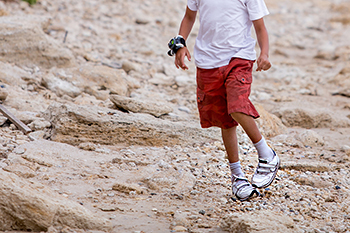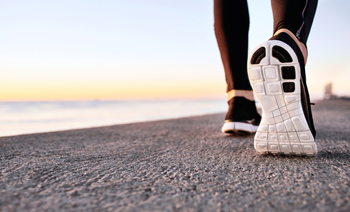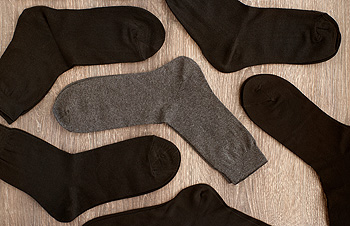Items filtered by date: July 2022
Two Categories of Clubfoot

Clubfoot is considered to be a congenital foot condition. The medical name for it is known as congenital talipes equinovarus, and the abbreviation is CTEV. A noticeable sign of this condition is that the infant's feet are rotated at the ankle. There are two categories of CTEV - postural and structural. The former involves tightness or muscle imbalance, and the bones and joints are generally not affected by this type of clubfoot. The latter is a deformity that affects the bones and joints, and reaching a full range of motion may be difficult to accomplish. The symptoms that are associated with CTEV can consist of tight calf muscles, and the feet will turn inward. Research has indicated that genetics and environment may contribute to developing structural CTEV. When walking begins, the child may have difficulty in maintaining a normal walking pattern, and they may have foot pain and limited mobility. Specific stretches can possibly help postural CTEV, and surgery may be necessary in structural CTEV, which may help to properly align the feet. If your child has been born with clubfoot, it is strongly advised that a podiatrist be contacted who can diagnose and manage this condition.
Congenital foot problems require immediate attention to avoid future complications. If you have any concerns, contact the foot specialists of Podiatry Associates of Belleville. Our doctors can provide the care you need to keep you pain-free and on your feet.
Congenital foot problems are deformities affecting the feet, toes, and/or ankles that children are born with. Some of these conditions have a genetic cause while others just happen. Some specific foot ailments that children may be born with include clubfeet, polydactyly/macrodactyly, and cleft foot. There are several other foot anomalies that can occur congenitally. What all of these conditions have in common is that a child may experience difficulty walking or performing everyday activities, as well as trouble finding footwear that fits their foot deformity. Some of these conditions are more serious than others. Consulting with a podiatrist as early as possible will help in properly diagnosing a child’s foot condition while getting the necessary treatment underway.
What are Causes of Congenital Foot Problem?
A congenital foot problem is one that happens to a child at birth. These conditions can be caused by a genetic predisposition, developmental or positional abnormalities during gestation, or with no known cause.
What are Symptoms of Congenital Foot Problems?
Symptoms vary by the congenital condition. Symptoms may consist of the following:
- Clubfoot, where tendons are shortened, bones are shaped differently, and the Achilles tendon is tight, causing the foot to point in and down. It is also possible for the soles of the feet to face each other.
- Polydactyly, which usually consists of a nubbin or small lump of tissue without a bone, a toe that is partially formed but has no joints, or an extra toe.
- Vertical talus, where the talus bone forms in the wrong position causing other bones in the foot to line up improperly, the front of the foot to point up, and the bottom of the foot to stiffen, with no arch, and to curve out.
- Tarsal coalition, when there is an abnormal connection of two or more bones in the foot leading to severe, rigid flatfoot.
- Cleft foot, where there are missing toes, a V-shaped cleft, and other anatomical differences.
- Macrodactyly, when the toes are abnormally large due to overgrowth of the underlying bone or soft tissue.
Treatment and Prevention
While there is nothing one can do to prevent congenital foot problems, raising awareness and receiving neonatal screenings are important. Early detection by taking your child to a podiatrist leads to the best outcome possible.
If you have any questions please feel free to contact our office located in Belleville, NJ . We offer the newest diagnostic tools and technology to treat your foot and ankle needs.
Differences Between Walking and Running Shoes

Countless Americans choose to get their daily dose of exercise and movement from walking and running. If you are one such person, it is imperative that you make yourself well acquainted with the critical differences between walking and running shoes. Despite the surface-level similarities between walking and running as activities, shoes for each activity are built differently to suit the differences between the activities. For example, running shoes have thicker and sturdier heel cushions than walking shoes. This is because the act of running requires putting more pressure and weight on the heel area of the foot. Running shoes also have wider heel cushions to provide the extra needed stability for runners. Additionally, running and walking shoes are different from each other because the former relies more heavily on having a sturdy mid-sole to essentially absorb the high impact running puts on the joints. Shock absorption is more important in running shoes because while running, individuals can put up to 200 pounds of weight impact onto their feet. You can use this information about the differences between walking and running shoes when shopping for both to know what features you should be on the lookout for. A podiatrist can help further clarify the differences and importance between these shoes.
For more information about walking shoes versus running shoes, consult with the foot specialists from Podiatry Associates of Belleville. Our doctors can measure your feet to determine what your needs are and help you find an appropriate pair of footwear.
Foot Health: The Differences between Walking & Running Shoes
There are great ways to stay in shape: running and walking are two great exercises to a healthy lifestyle. It is important to know that running shoes and walking shoes are not interchangeable. There is a key difference on how the feet hit the ground when someone is running or walking. This is why one should be aware that a shoe is designed differently for each activity.
You may be asking yourself what the real differences are between walking and running shoes and the answers may shock you.
Differences
Walking doesn’t involve as much stress or impact on the feet as running does. However, this doesn’t mean that you should be any less prepared. When you’re walking, you land on your heels and have your foot roll forward. This rolling motion requires additional support to the feet.
Flexibility – Walking shoes are designed to have soft, flexible soles. This allows the walker to push off easily with each step.
If you have any questions, please feel free to contact our office located in Belleville, NJ . We offer the newest diagnostic and treatment technologies for all your foot care needs.
A Partial or Complete Achilles Tendon Rupture

The Achilles tendon is responsible for pointing and flexing the foot, which is necessary in walking and running. It is located at the back of the heel, and connects the calf muscles to the heel. An Achilles tendon injury can occur from increasing speed and distance too quickly while running, or not properly warming up and cooling down. A tear may occur, and if the rupture is partial, the tendon remains attached to the calf muscle. A complete tear, where there is no connection between the tendon and muscle, is known as a rupture, and it is very painful and difficult to walk. This can happen as a result of high levels of stress put on the Achilles tendon from participating in activities that can include tennis, basketball, and football. There may be existing medical conditions and medications that can weaken the Achilles tendon and contribute to enduring an injury, such as Cushing’s syndrome, prednisolone, and ciprofloxacin. Common symptoms that many patients experience can be the inability to stand on their tiptoes, and there may be a flat-footed walking style. An Achilles tendon injury can be treated in different ways, and it is suggested that you urgently consult the expertise of a podiatrist who can determine what is best for you.
Achilles tendon injuries need immediate attention to avoid future complications. If you have any concerns, contact the foot specialists of Podiatry Associates of Belleville. Our doctors can provide the care you need to keep you pain-free and on your feet.
What Is the Achilles Tendon?
The Achilles tendon is a tendon that connects the lower leg muscles and calf to the heel of the foot. It is the strongest tendon in the human body and is essential for making movement possible. Because this tendon is such an integral part of the body, any injuries to it can create immense difficulties and should immediately be presented to a doctor.
What Are the Symptoms of an Achilles Tendon Injury?
There are various types of injuries that can affect the Achilles tendon. The two most common injuries are Achilles tendinitis and ruptures of the tendon.
Achilles Tendinitis Symptoms
- Inflammation
- Dull to severe pain
- Increased blood flow to the tendon
- Thickening of the tendon
Rupture Symptoms
- Extreme pain and swelling in the foot
- Total immobility
Treatment and Prevention
Achilles tendon injuries are diagnosed by a thorough physical evaluation, which can include an MRI. Treatment involves rest, physical therapy, and in some cases, surgery. However, various preventative measures can be taken to avoid these injuries, such as:
- Thorough stretching of the tendon before and after exercise
- Strengthening exercises like calf raises, squats, leg curls, leg extensions, leg raises, lunges, and leg presses
If you have any questions please feel free to contact our office located in Belleville, NJ . We offer the newest diagnostic tools and technology to treat your foot and ankle needs.
Gout Pain Can Be Managed
Diabetic Socks Could Be an Important Part of Your Foot Care Routine

Individuals with diabetes ought to be especially diligent in practicing healthy foot care. This is because diabetes can negatively impact nerves and restrict blood circulation throughout the feet. There are a number of ways in which diabetics may go about taking care of their foot health. One of these ways is by wearing diabetic socks, which are specially designed to help prevent common diabetic side effects in the feet. Some diabetic socks use non-elastic binding that holds the sock up on the calf without restricting blood flow to the feet. Other kinds of diabetic socks feature smart technology that can help the wearer identify an incoming ulcer or other problem. Since high blood pressure associated with diabetes can cause ulcers, diabetic socks usually are made without seams to reduce the kind of friction that could create an ulcer. Diabetic socks may not be right for everyone living with diabetes, so you might consider consulting with a podiatrist to see if these socks would work for you.
Diabetic foot care is important in preventing foot ailments such as ulcers. If you are suffering from diabetes or have any other concerns about your feet, contact the foot specialists from Podiatry Associates of Belleville. Our doctors can provide the care you need to keep you pain-free and on your feet.
Diabetic Foot Care
Diabetes affects millions of people every year. The condition can damage blood vessels in many parts of the body, especially the feet. Because of this, taking care of your feet is essential if you have diabetes, and having a podiatrist help monitor your foot health is highly recommended.
The Importance of Caring for Your Feet
- Routinely inspect your feet for bruises or sores.
- Wear socks that fit your feet comfortably.
- Wear comfortable shoes that provide adequate support.
Patients with diabetes should have their doctor monitor their blood levels, as blood sugar levels play such a huge role in diabetic care. Monitoring these levels on a regular basis is highly advised.
It is always best to inform your healthcare professional of any concerns you may have regarding your feet, especially for diabetic patients. Early treatment and routine foot examinations are keys to maintaining proper health, especially because severe complications can arise if proper treatment is not applied.
If you have any questions please feel free to contact our office located in Belleville, NJ . We offer the newest diagnostic and treatment technologies for all your foot and ankle needs.
